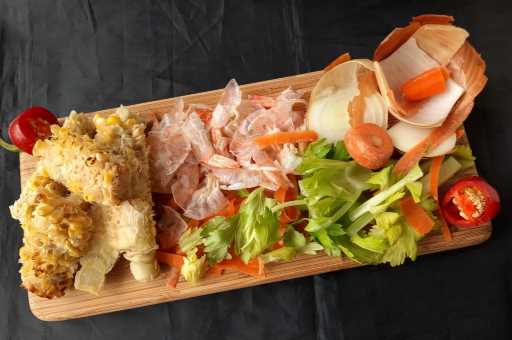Water that’s boiling is boring. Stock that’s boiling is not.
Many cooks routinely make stocks (some call them broths) using leftover chicken carcasses or steak bones, mushroom stems and other vegetable peelings or discards, even fish bones or crab and lobster carapaces.
These we freeze and then utilize for all manner of wet cooking: stews, soups and as the basis of braises and glazes.
By and large, all that is autumn or winter cooking, however, reaching its apogee in late November when rivers of chicken stock tsunami through the kitchen to prepare Thanksgiving Day dinner.
At the beginning of summer, though, I suggest that we comfort ourselves and our cooking by making and using stocks — certainly ones that are lighter and brighter — to add flavor to the cooling foods of warmer weather such as grain salads, poached and chilled fish filets or cold soups such as gazpacho or vichyssoise.
Or, for indeed almost all summer cooking. Why not boil the kidney beans for a three-bean salad in a light stock made of vegetable peelings? You’d ramp up the flavor some few notches that way. Same for boiling pasta, farro, rice or potatoes for other summer salads, or even if any is served merely as a side.
The main idea is to find flavor, always and everywhere, to add to whatever cooking we do.
I recently enjoyed a pail of mussels that had been heated and opened over a corn cob broth enriched with herbs, white wine and spices. The extra layer of flavor afforded by the corn cob broth was both delicious and welcome.
The core recipe here is the base for two summer stocks, one made of corn cobs, the other of shrimp peels. The third recipe (which works year-round) is a light, nearly diaphanous stock quickly rendered from common vegetable peelings kept in the freezer for just such.
Summer Stock Base
Makes 8 cups.
Ingredients
- 2 tablespoons good-quality olive oil
- 1 yellow or white onion, unpeeled and halved along its “poles”
- 2 garlic cloves, unpeeled and smashed lightly
- 1 bay leaf
- 20 black peppercorns
- 20 coriander seeds
- 3-4 sprigs (or stems only) flat-leaf parsley
- 1 1-inch piece fresh ginger, unpeeled (optional)
- A scant handful celery leaves (optional)
- 10-12 carrot peels (optional)
- 8 cups water
Directions
Over medium-high heat, place a large heavy-bottomed pot or Dutch oven. Heat the olive oil and, when it shimmers, add the onion halves, cut-side down, and leave them to cook, without jostling, until they are well charred, about 5-6 minutes.
Move the onions to the side and place the remaining ingredients, except for the water, in the center of the pot and gently stir them around until they become aromatic, about 90 seconds (or a bit more if using celery leaves and carrot peels).
Add the water and other solids (for example corn cobs or shrimp peels), bring to a boil, then lower to a simmer. Cook, uncovered, for 60 minutes, stirring gently only once or twice.
Remove from the heat and let cool down slightly, then pour through a fine-mesh sieve or colander, either lined with cheesecloth, set over a large bowl. When cool enough to portion, freeze in containers of suitable size for use in further preparations.
For corn cob stock: Use anywhere from 6-8 full-length cobs (or their equivalent in smaller cobs) that have been shorn of most of their kernels. It’s OK (even better) if the corn was previously grilled. You also may add a rind or two of Parmigiano-Reggiano cheese to the stock along with the cobs. That will add extra umami.
For shrimp stock: Use anywhere from 4-6 cups of shrimp shells, peeled from cooked or raw (but thawed) shrimp. You also may add 1/2 lemon to the stock along with the shells.
Vegetable Peelings Stock
If using potato peels, use only a few; they can cloud a stock. Avoid cruciferous vegetables such as cauliflower or broccoli because they can make a stock bitter. Also avoid most cabbages for the same reason, except the more tender parts of Napa cabbage. Makes 8 cups.
Ingredients
- 2 tablespoons good-quality olive oil
- 2 garlic cloves, unpeeled and smashed lightly
- 1 bay leaf
- 10 black peppercorns
- 10 coriander seeds
- 1 1-inch piece fresh ginger, unpeeled (optional)
- A few stems of flat-leaf parsley or stems of delicate herbs such as thyme or savory (optional)
- 4-5 cups assorted vegetable peelings (all parts of onion, leek, carrot, celery, turnip, tomato, chard, mushroom or scallion)
- 8 cups water
Directions
Over medium-high heat, place a large heavy-bottomed pot or Dutch oven. Heat the olive oil and, when it shimmers, add the garlic, bay leaf, peppercorns and coriander seeds and gently stir them around until they become aromatic, about 90 seconds.
Add the water and the vegetable peelings and optional ginger and herb stems, bring to a boil, then lower to a simmer. Cook, uncovered, for 20-25 minutes, no longer, stirring gently only once or twice.
Remove from the heat and let cool down slightly, then pour through a fine-mesh sieve or colander, either lined with cheesecloth, set over a large bowl. When cool enough to portion, freeze in containers of suitable size for use in further preparations.
Subscribe to our weekly newsletter, In The Know, to get entertainment news sent straight to your inbox.
Source: Read Full Article

